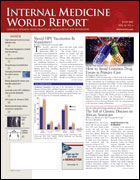Publication
Article
Internal Medicine World Report
Look for Involuntary Emotional Expression Disorder
Author(s):
BOSTON—Primary care physicians need to be more attuned to the possibility of involuntary emotional expression disorder in their patients with neurologic disease or a history of brain injury, investigators said at the American Academy of Neurology annual meeting. The recommendation comes in the wake of a study that showed involuntary emotional expression disorder was frequently undiagnosed and untreated.
In addition, the condition is often inadequately controlled when treated off-label with antidepressants and/or antipsychotics.
"The findings mean that doctors need to do a better job of screening their patients for involuntary emotional expression disorder," said Walter G. Bradley, DM, FRCP, chairman emeritus of the Department of Neurology at the University of Miami Miller School of Medicine.
With regard to treatment, he said, "it is worthwhile to try antidepressants and antipsychotics in the absence of an FDA-approved treatment for involuntary emotional expression disorder, even though they do not always control the condition completely."
Involuntary emotional expression disorder occurs as a result of a neurologic disease or a brain injury. Other common names for the condition include pseudobulbar affect, emotional lability, and pathological laughing and crying. "Personally, I prefer the term ‘emotional incontinence,' since the condition really refers to a person's inability to maintain control of their emotions," Dr Bradley said.
Key Points
- Involuntary emotional expression disorder is often misdiagnosed, because symptoms can mimic other conditions.
- The disorder is characterized by uncontrollable episodes of crying and/or laughing or related facial displays that are inconsistent with underlying mood.
- Consider antidepressants or antipsychotics until more specific treatment is available.
Hallmark symptoms are uncontrollable episodes of crying and/or laughing and related facial displays that are incongruent or exaggerated in relation to underlying mood.
Episodes are often sudden and unpredictable, and are uniformly distressing and/or produce clinically significant impairments in social, occupational, or other important aspects of functioning.
This study assessed the prevalence of this disorder by the most often associated underlying diseases—multiple sclerosis, amyotrophic lateral sclerosis, Alzheimer's disease, stroke, or Parkinson's disease—or by traumatic brain injury. The survey also addressed patient interactions with physicians to evaluate the extent of diagnosis and treatment.
The overall prevalence of the disorder was 9.5% based on one score and 10.1% based on another score. "Depending on the criteria used, this means that there are between a half million and 2 million people in the United States with this condition," Dr Bradley said.
Even though as many as 59% of patients with involuntary emotional expression disorder discussed their symptoms with a physician, fewer than 50% of them had been given a diagnosis or prescribed treatment to alleviate the problem.
In addition, 50% of treated patients receiving antidepressants, antipsychotics, or both still had scores on both scales indicative of symptomatic illness.
"Patients with involuntary emotional expression disorder have been neglected because as a treating physician, you treat people for conditions that you can treat," Dr Bradley said. "You don't necessarily worry too much about symptoms you know you can't treat."
An investigational agent is under FDA review for the treatment of this disorder. If approved, it would be the first therapy specifically indicated for this condition.
Home-Based Therapy Improves Vision after Brain Injury
BOSTON—More than two thirds of patients who have become partially blind after a stroke or traumatic brain injury are able to recover some of their vision with a short course of vision restoration therapy (VRT), according to data released at the American Academy of Neurology annual meeting.
Jose G. Romano, MD, associate professor of neurology at the University of Miami, and colleagues reviewed results in 161 patients who had developed postchiasmatic lesions and homonymous visual field defects >3 months after their injury.
After clinical assessment and diagnostic testing, patients participated in a customized VRT program intended to improve their visual field deficit. Through use of visual stimuli that targets the border between the visual and the blind fields, users can gradually expand their visual fields and restore the lost vision. The VRT program is FDA approved and is usually completed in 6 months.
In 70% of patients, stimuli detection improved by ≥3%. An improvement of this magnitude has been shown to correlate with subjective improvement in the patient's ability to perform daily activities. The mean average improvement in stimulus detection was 12.8%.
"We believe that this rehabilitative therapy provides important functional gains to patients that were once thought to be lost forever," Dr Romano said. "Until now, patients have had to use eyeglasses with custom-fit prisms that are sometimes helpful but do not restore vision lost due to stroke or traumatic brain injury."
—J.S.
There are about 2 million stroke and traumatic brain injury survivors in the United States who have major visual field deficits. The American Heart Association reports this number is increasing by 100,000 annually.





